132items
-
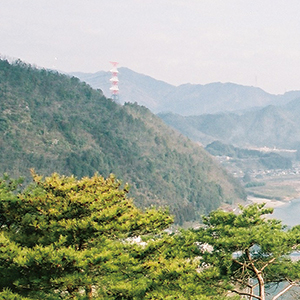
Aerial Perspective
空気遠近法
Kuuki-enkinhou
Aerial perspective is a method of spatial expression which uses the properties of the atmosphere. For example, when looking at a landscape outside, objects that are further away will appear bluish and hazy with less distinct contours. Taking these
-

Drypoint
ドライポイント
Drypoint
Drypoint is a type of direct intaglio technique (direct carving method) in which a metal plate is carved out directly to create a drawing. The image is carved directly on the plate surface using steel needles etc. which are harder than the plate itse
-
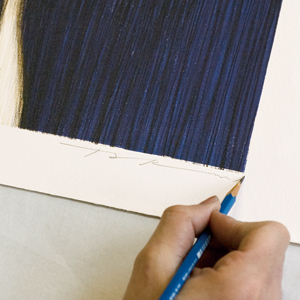
Original Print
オリジナル版画
Original Hanga
An original print is a print work produced with the clear intention of the artist, and is one which was completed with the direct involvement of the artist in the making process. Several conditions apply to qualify as an original print. They are:
-

Engraving
エングレーヴィング
Engraving
Engraving is a type of direct intaglio technique (direct carving method) in which a metal plate is carved out directly to create a drawing. A tool called a burin is used to score lines (the image) directly on the printing plate. A feature of this tec
-
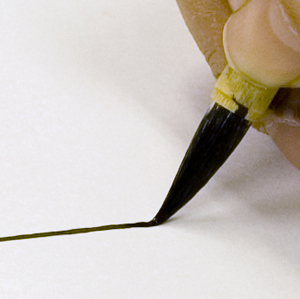
Tessenbyo
鉄線描
Tessenbyou
Tessenbyo literally means a steel wire line and refers to a sharp line of uniform width. It is a typical type of line used in Japanese paintings. Lines constitute a key element of Japanese paintings, forming the framework of a painting. In contras
-
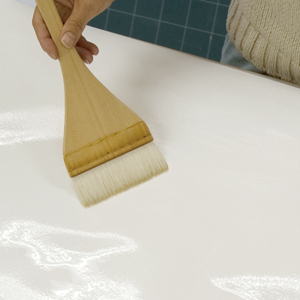
Water Tensioning
水張り
Mizubari
When producing watercolors and Japanese paintings etc., the paper is first stretched on a wooden panel etc. This process utilizes the characteristic of paper whereby it expands when moistened with water and shrinks back to its original size as it dri
-
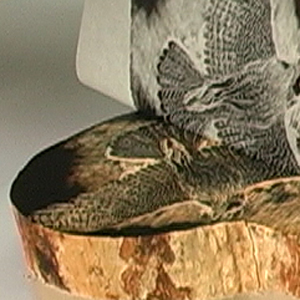
Wood Engraving
木口木版
Koguchimokuhan
Wood engraving is a type of woodblock printing in which a block of wood with a hard surface, made by slicing a tree into rings, is used for the printing block. This block can be carved with intricate details using a burin. Sometimes referred to as
-
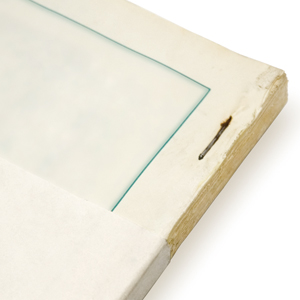
Side-stitch Binding
平綴じ
Hiratoji
Side-stitch binding refers to the method of binding magazines and booklets by forcing a wire through the side of the signature (printed paper folded into the size of the booklet), from the front to the back, near the spine. This simple method was
-
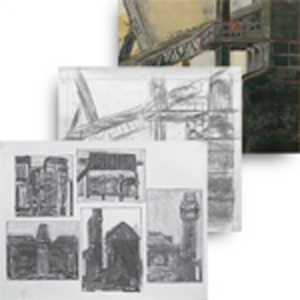
Koshitazu
小下図
Koshitazu
Koshitazu (small sketch) refers to the many small sketches that are drawn to plan out the image and direction of a painting before starting on the actual piece. It is also called kojitae or esquisse. Koshitazu is prepared to determine the composit
-

Sewn Binding
糸綴じ
Itotoji
Books and booklets can be made by sewing together the spine of the signatures (printed paper folded into the size of the book) with thread. This technique is called itotoji (sewn binding) or kagari. Because books made this way are strong and can be o
-
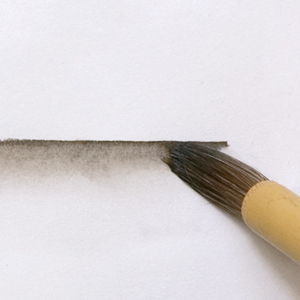
Kumadori
隈取り
Kumadori
Kumadori is a representation method for blurring or adding gradations to a Japanese painting. This is also referred to as bokashi. Kumadori emphasizes the three-dimensional shape of the painted object and also has a decorative effect. The blurred
-
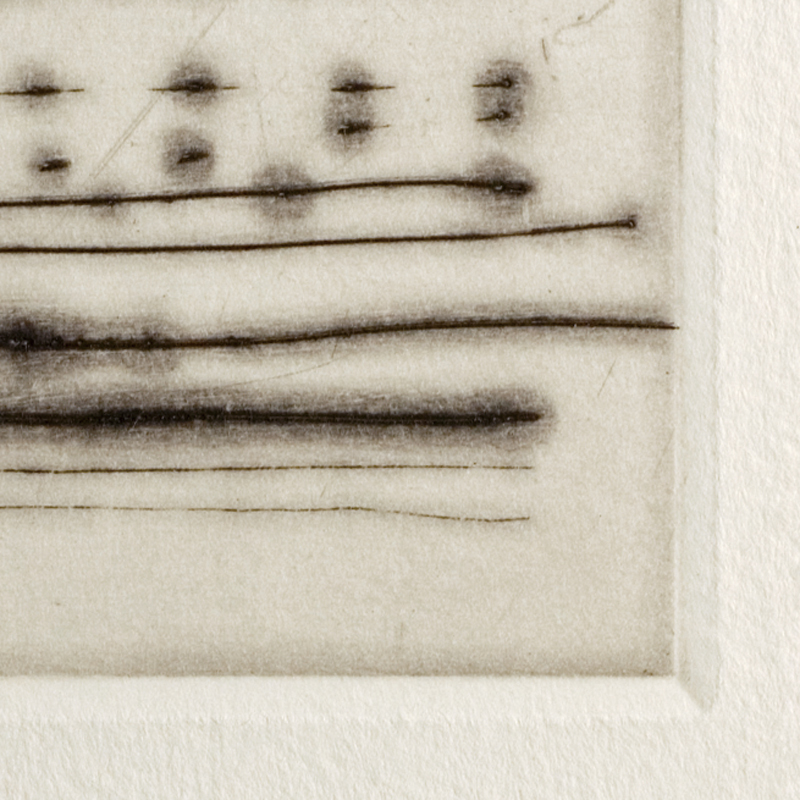
Plate Mark
プレートマーク
Plate Mark
A plate mark is a depression unique to copper plate prints produced when a plate is printed. To ensure that the plate feeds smoothly into the rollers of the printing press and that the paper or felt on which the image is printed does not tear, the
-
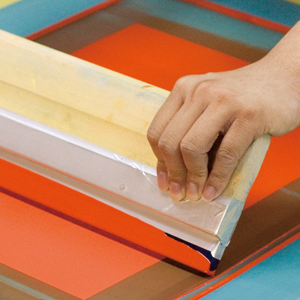
Screen Printing
スクリーンプリント
Screen Printing
Screen printing is a typical form of stencil printing. It uses a stencil made from a mesh of tetron or other smooth fiber stretched on a wooden or metal frame. Emulsion is used to block up this mesh, leaving openings in the image section only. Ink is
-
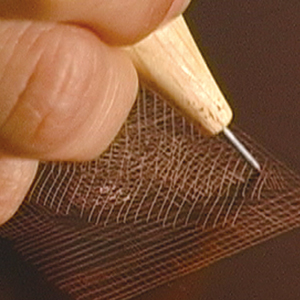
Etching
エッチング
Ecching
Etching is an indirect intaglio printmaking technique in which the metal plate is prepared through corrosion. A needle is used to scratch and peel off the anticorrosive coating on the plate to expose the metal surface. When this plate is immersed in
-
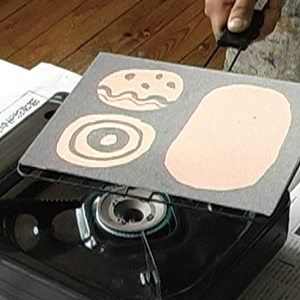
Aquatint
アクアチント
Acuachinto
Aquatint is an intaglio printmaking technique and a variant of etching (indirect intaglio) in which the metal plate is prepared through corrosion. A porous plate surface is produced by sprinkling powdered pine resin or asphalt on the surface of the p
-
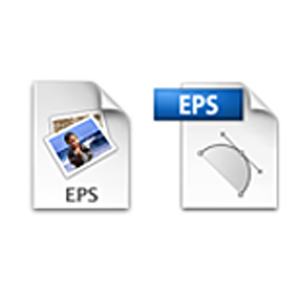
EPS
EPS
EPS
EPS, which stands for Encapsulated PostScript, is a file format for graphic data which uses a technology known as PostScript. It carries the extension, .eps. Because it can include vector data and bit map data, it is used as the file format for both
-
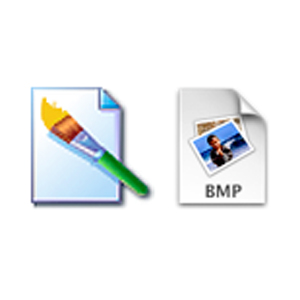
BMP
BMP
BMP
BMP is the standard file format for bit map data in Windows (There is also a slightly different BMP in the OS/2 format). It carries the extension, .bmp. BMP files can be viewed and edited with the Windows accessory program, MS Paint, and is compatibl
-
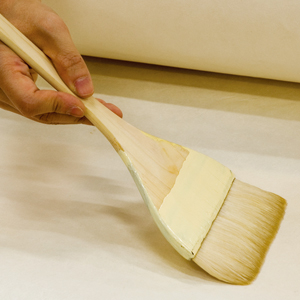
Dosabiki (Sizing)
礬水引き
Dousabiki
Dosabiki (sizing) is the technique of treating washi and eginu (silk canvas) used as the support medium for Japanese paintings, to prevent the ink from smudging. This is done on "raw" washi and various other support elements. Sizing is best carrie
-

Quantization
量子化
Ryoushika
This is the process of converting analog data such as images and audio into digital data is called analog-digital (A-D) conversion. A-D conversion is performed via two processes: sampling and quantization. Quantization is the process of converting sa
-

Sampling
標本化
Hyouhonka
The process of converting analog data such as images and audio into digital data is called analog-digital (A-D) conversion. A-D conversion is performed via two processes: sampling and quantization. Sampling is the process of measuring continuously ch
-

Color Perspective
色彩遠近法
Shikisai-enkinhou
Color perspective is a method of spatial expression using a psychological technique with color and visual effect. Color can be broadly divided into warm and cold colors. Warm colors such as red and yellow convey a feeling of compression, of being pro
-
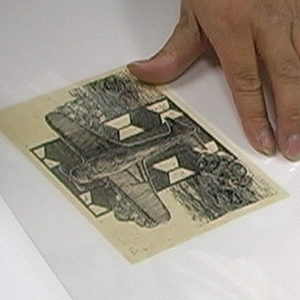
Backing (Prints)
裏打ち(版画)
Urauchi (Hanga)
Backing is a technique used in lithography and wood engraving in which works printed on ganpishi and other thin paper are mounted on a thicker, sturdier backing paper. Although this method is often used in wood engraving where the work is hand-pri
-

Oshitazu
大下図
Oshitazu
Oshitazu (preliminary sketch) is an outline of the work sketched in full size before starting on the actual piece. It is also referred to as oshitae (rough sketch) or soko (draft). In Japanese paintings, oshitazu is drawn on a separate medium to t
-
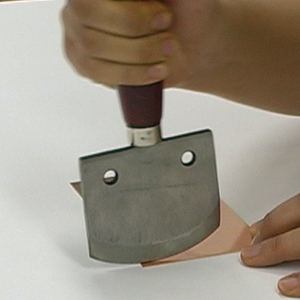
Mezzotint
メゾチント
Mezzotint
Mezzotint is a type of direct intaglio method in which the plate is roughened with countless burrs (dots), using tools such as a rocker, before it is carved to produce soft expressions which are rich in tone and shade contrasts. In French, it is also
-
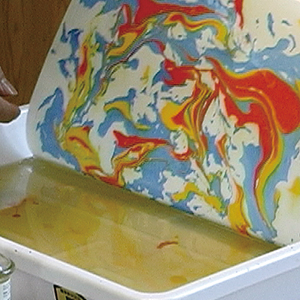
Marbling
マーブリング
Marbling
Marbling is a method of transferring complex designs and patterns created on the water surface by sprinkling water-repellant colorants in aqueous solution of rubber resin to paper. It is said that marbling has originated in Turkey in the 15th cent
-
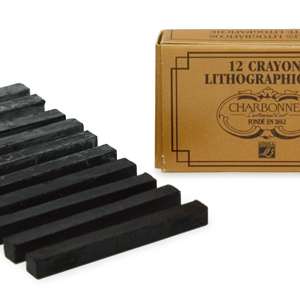
Lithographic Crayons
リトクレヨン
Litocrayon
Lithographic crayons are crayons with a high oil content used in lithography. They are available in pencil and stick (like Conte crayons) forms. Both types come in varying degrees of hardness so they should be selected according to drawing conditi
-
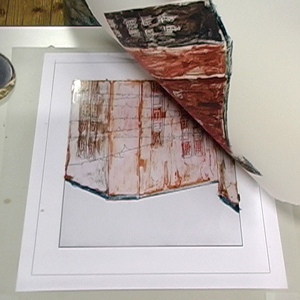
Monotype
モノタイプ
Monotype
Monotypes are created by drawing an image directly on a plate with ink or oil paint, placing a piece of paper on top and applying pressure to transfer the image on the plate to the paper. They are also sometimes referred to as monoprints. "Mono" i
-
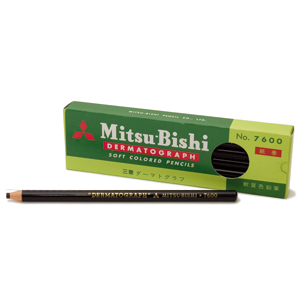
Dermatograph
ダーマトグラフ
Dermatograph
A dermatograph is a colored pencil made of rolled paper and is used in block printing instead of a lithographic crayon when doing lithographs. A dermatograph is made of paper wound into a pencil shape. Unlike a conventional pencil, it is unique in
-

Screen Frame
スクリーン枠
Screen-waku
A screen frame is the frame on which a mesh (made of tetron, nylon, silk, etc.) stencil for screen printing is stretched. The frames come in various sizes but they must be slightly larger than the actual image to be printed (image size) because a squ
-

Rubber Spatula
ゴムベラ
Gomubera
Rubber spatulas are used mainly for copper plate and wood intaglio printing and for removing excess ink from the block. They generally comprise a wooden handle with a piece of rounded rubber on the end or a squeegee large enough to fit in the hand.
-

Kakiron, Keshiron
カキロン・ケシロン
Kakiron, Keshiron
Kakiron (touch up pen) and keshiron (eraser pen) are pen-type tools for making corrections to finished plates used in metal lithography. Since both these instruments rely on chemical reactions, they do not require conventional surface treatment on th
-
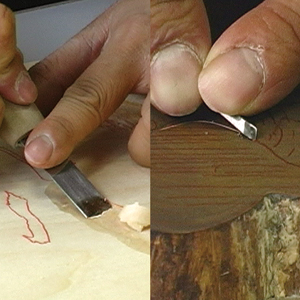
Woodblock Printing
木版画
Mokuhanga
Woodblock printing is a typical type of relief printing using wooden printing blocks. Ink (paint) is loaded on to the relief sections of the printing plate that have been carved out using carving tools, and is transferred to the paper by applying pre
-
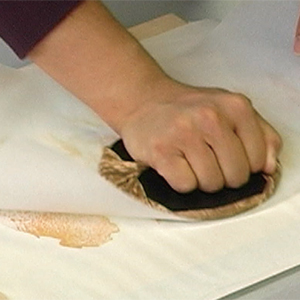
Woodcut
板目木版
Itamemokuhan
Woodcut is a type of woodblock printing in which a board, cut out vertically along the grain of the wood, is used as the printing block. In Japan, there has long been a culture of woodcut prints such as ukiyo-e, and woodblock printing using woodcut b
-
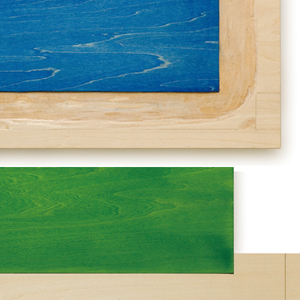
Uchi Kento & Soto Kento
内見当・外見当
Uchikentou・Sotokentou
Uchi kento and soto kento are registration marks that determine the position of the paper in woodblock printing. A registration mark carved within the woodblock is called uchi kento while one carved into a separate wood board, known as a kentoban, is
-

Copperplate Printing
銅版画
Douhanga
Copperplate printing is one of the forms of intaglio printing in which grooves are formed in a pressed copperplate by a physical process such as engraving or acid etching. Ink is then packed into this and is transferred from the plate to paper with a
-
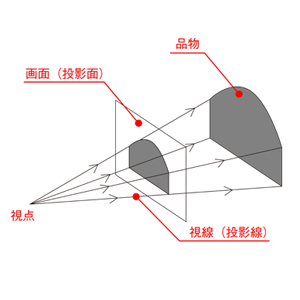
Perspective Projection
透視投影
Toushitouei
Perspective projections are also called central projections and are one technique for showing a three-dimensional object on a flat surface. They are called perspective drawings or "pers" for short. Because they enable the creator to produce an identi
-
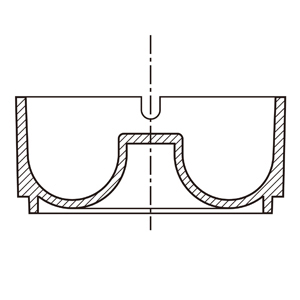
Section Diagram
断面図
Danmenzu
Section diagrams are auxiliary diagrams showing parts that are not visible. Invisible parts in a three dimensional object are shown by hidden outlines (broken lines) but if too many are used, the blueprint becomes complicated and difficult to read. T
-
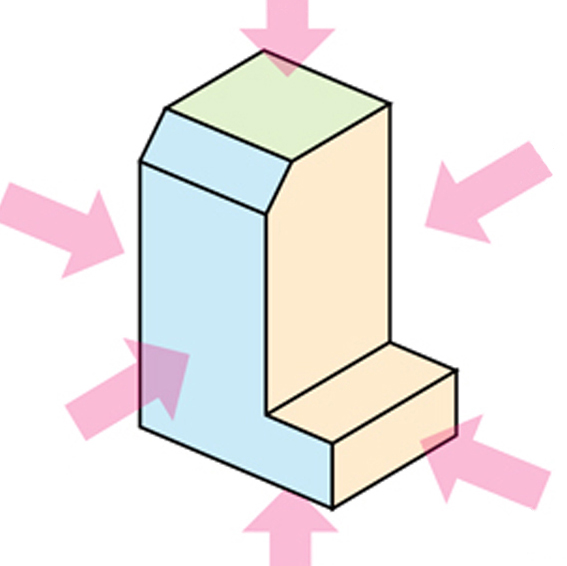
Orthographic Projection
正投影図法
Seitoueizuhou
Projection methods are broadly divided into perspective and parallel projection. Projection is a means of representing a three-dimensional object in two dimensions and orthographic projection is a form of parallel projection. A feature of orthographi
-
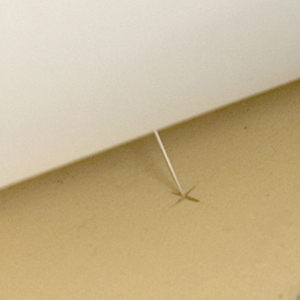
Hari Kento
針見当
Harikentou
Hari kento is a registration method used in lithography and multi-color copperplate printing to place the printing paper in the correct position against the plate using needles. This technique is employed in normal printing, and also when the pape
-

Kotsugaki
骨描き
Kotsugaki
Kotsugaki is the technique of outlining in sumi ink before adding colors. Kotsu means outline. The outline of a picture becomes an important part of the coloring process. In addition to Japanese painting, the technique is also used in adding artwork
-

Registration Marks
見当
Kento
Registration marks (kento) are placed on the printing plates to position the paper correctly for printing. They are indispensable, particularly for works produced through multiple printing. The quality of the work will depend greatly on the accuracy
-
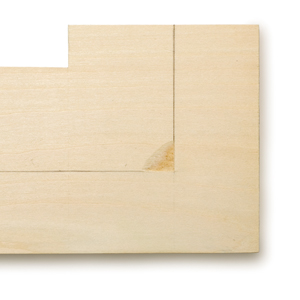
Kagi Kento and Hikitsuke Kento
カギ見当・引き付け見当
Kagikento・Hikitsukekento
Kagi kento (L-mark) and hikitsuke kento (straight mark) are L-shaped and straight-line registration marks that are carved on the woodblock as markers for accurately placing the paper in the correct position for printing. The L-mark is carved on th
-
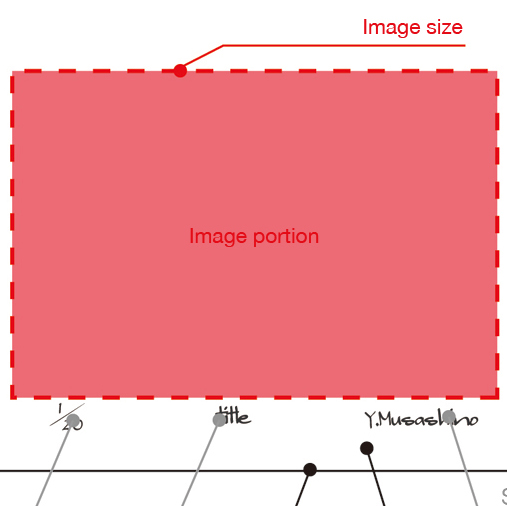
Image Size
イメージサイズ
Image Size
Image size is the dimensions of an image left on paper (medium) by a plate in block print works and the size is expressed in length x width. Block prints are accomplished by printing on paper or some other medium. The medium for many block prints
-
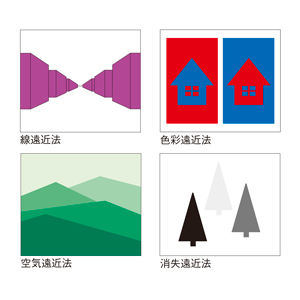
Perspective
遠近法
Enkinhou
Perspective is the technique of representing three-dimensional space around us on a flat, two-dimensional surface (painting, drawing, etc.) without compromising spatial relations such as the notions of far and near, high and low, and wide and narrow.
-
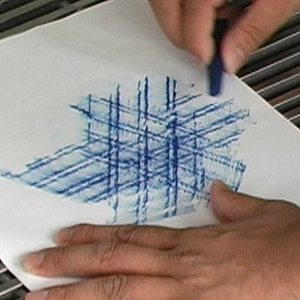
Frottage
フロッタージュ
Frottage
Frottage is the technique of copying the texture and shape of an object by placing a sheet of paper on top and rubbing with a pencil or similar implement. The term comes from the French word, "frotter", meaning, "to rub". There are a variety of co
-
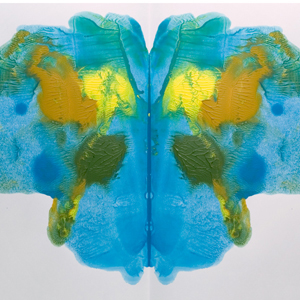
Decalcomania
デカルコマニー
Decalcomania
Decalcomania, from the French décalcomanie, is the technique of placing paint between two sheets of paper or between paper and some other material and pressing down and spreading the paint. This produces a random pattern over which the artist has no
-
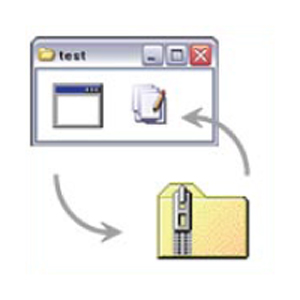
Lossless Compression
可逆圧縮
Kagyakuasshuku
The compression method in which the original data can be restored from the compressed data is called lossless compression. It would be meaningless to compress and reduce the size of text and program data if data is lost in the process. That is why lo
-

Lead
リード
Lead
A lead is a short sentence or paragraph placed between the headline and the article in newspapers, magazines and other publications providing a précis of the article and intended to stimulate reader interest. To distinguish it from the article and th
-
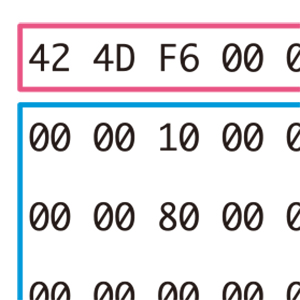
File Format
ファイルフォーマット
File Format
A computer handles various data such as text, image, audio and video in files. The specific way in which data is stored in a file is called the file format. All data processed on a computer are binary data that can be expressed in 0s and 1s. In ot
-
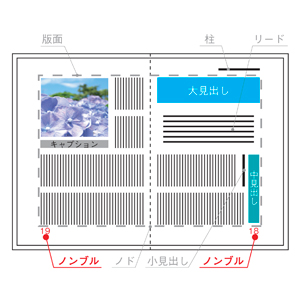
Numbering
ノンブル
Nonburu
Numbering refers to the numbering of pages and in Japanese publications is called nombre, from the French word. Books, magazines and other bound publications have the page number displayed on each page. This is also called pagination. Numbering ge
-
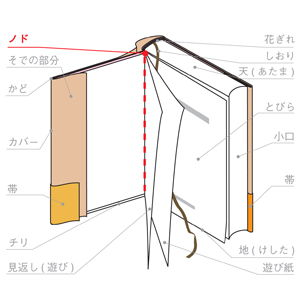
Gutter
ノド
Nodo
Gutter is the term for the bound sections (inner margins) of a book, magazine or other publication. It also refers to the margins between the printed text and the binding on any book or magazine surface. Setting the correct margin for the gutter w
-
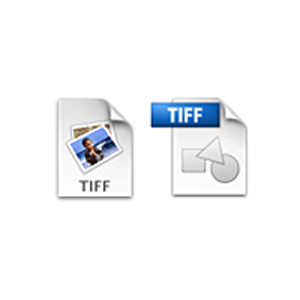
TIFF
TIFF
TIFF
TIFF is the abbreviation for Tagged Image File Format and is a bitmap data file format. It carries the extension, .tif. Using codes called tags to recognize data content enables information related to images to be stored in files. It is compatible
-

PSD
PSD
PSD
PSD is a bitmap data file format and is the native file format to the graphics editing software, Adobe Photoshop. It carries the extension, .psd. It is also known as the Photoshop format. Adobe Photoshop is a multifunctional graphics processing so
-
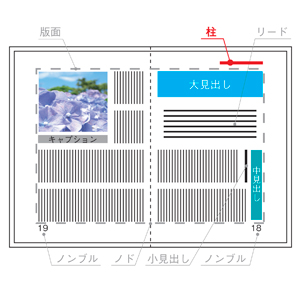
Headers and Footers
柱
Hashira
Headers and footers carry the document title, chapter, section and/or main points and are positioned in the margin area outside the main text area on pages of books, magazines, and other book-type publications. The purpose of this information is to m
-

Fore Edge
小口
Koguchi
The fore edge of a book, magazine or other bound publication is the transverse section on the side opposite the binding (spine). The Japanese term, koguchi, essentially means transverse section. In the general book production process today, when a
-
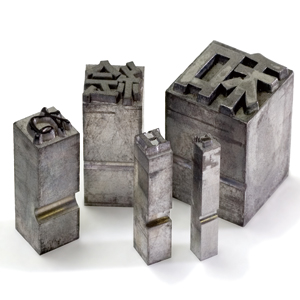
Metal Type
金属活字
Kinzokukatsuji
Metal type is usually cast in an alloy mainly made of lead. It is a piece of metal shaped into a rectangular prism with a top surface which is the size of the letter and a height of around 24mm, and is used in a combination to produce a type page for
-
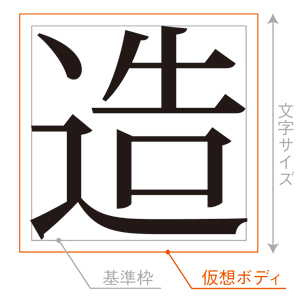
Imaginary Body
仮想ボディ
Kasoubodi
Imaginary body refers to the frame that will be the size standard when designing a font. A 12-point (1 point = 0.3514mm) font, for example, will be designed within a 4.217mm x 4.217mm frame. That frame is the imaginary body. The size of the letter is
-
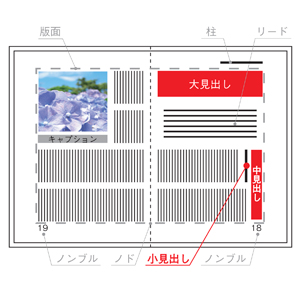
Headings
見出し
Midashi
A heading is a title placed at the beginning of a passage to provide a concise description of its content. In books, it refers to the titles given to each segment of the text according to chapter, section, paragraph, etc. In newspapers and magazines,
-
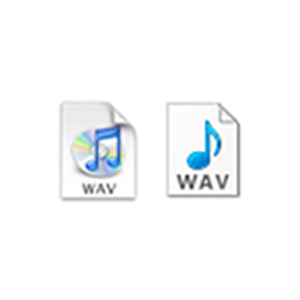
WAVE
WAVE
WAVE
When converting analog sound into digital data, it needs to go through a sampling and quantizing analog - digital (A-D) conversion process. The digitization of sound in this way is known as PCM (Pulse Code Modulation). WAVE is one of the principal
-

PNG
PNG
PNG
PNG, short for Portable Network Graphics, is a bitmap data file format. The file extension for it is ".png". PNG is a lossless compression file format for use on networks supporting 8-bit and 24-bit colors with the ability to achieve image transpare
-

Lossy Compression
非可逆圧縮
Hikagyakuasshuku
If data is deleted to reduce the size during compression, that data cannot be restored. This type of compression method in which the original data cannot be restored from the compressed data is referred to as lossy compression. Because image, audio a
-
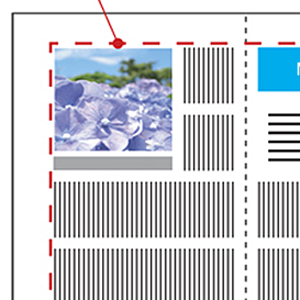
Hanmen
版面
Hanmen
Hanmen or hanzura (type page) originally referred to the entire printed area. It now primarily refers to the type area or printed region that makes up the contents of pages in books and magazines. In the latter case, secondary elements such as header
-
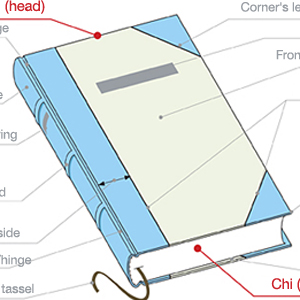
Ten (Head) and Chi (Foot)
天・地
Ten・Chi
Ten (head) refers to the top edge of pages in bound books and magazines. Chi (foot) refers to the bottom edge of those pages. Each of these is part of what is known as the koguchi (fore edge) in its broad sense. There are also occasions in which thes
-
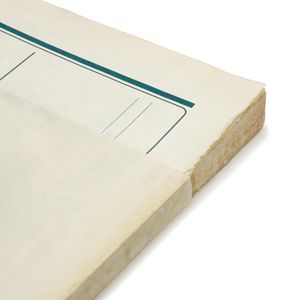
Adhesive Binding
無線綴じ
Musentoji
Adhesive binding (case binding) is the binding of all of the signatures (the printed sheets folded to the size of a book) that make up a book or a magazine at the spring using an adhesive. In the past, the tendency of pages to detach used to be a
-
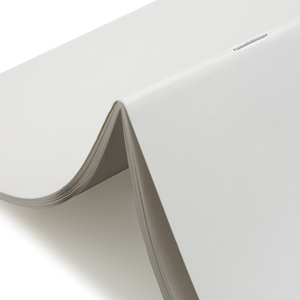
Saddle Stitch Binding (Inner Binding)
中綴じ
Nakatoji
Saddle stitch binding is the method for the binding together, using a wire (for example) from the center of the cover to the gutter, both of the covers and all of the signatures (the printed sheets folded to the size of a book) that made up the conte
-
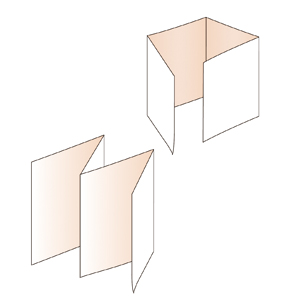
Folding
折り
Ori
Folding, in the case of books or magazines, is the name for the process by which the printed sheets are folded, accordion style, into the size of a book. Normally, books are made using sheets with multiple pages printed on each side, and then fold
-
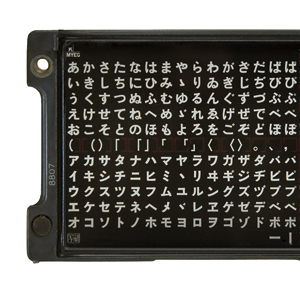
Photocomposition
写真植字
Shashinshokuji
Photocomposition (or phototypesetting) is one technology for creating paste ups, which are used in printing characters. Early printing technology involved the assembly of movable type, metal pieces upon which characters had been carved individually,
-
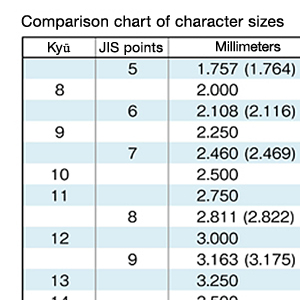
Kyū, Ha, Point
級・歯・ポイント
Kyū・Ha・Pointo
Kyū (級) is a unit of measurement used to express the size of characters in photocomposition that is particular to Japan; it is equal to 0.25mm. It can also be written as “Q,” an abbreviation that is derived from the origin of its name, “quarter,” as
-
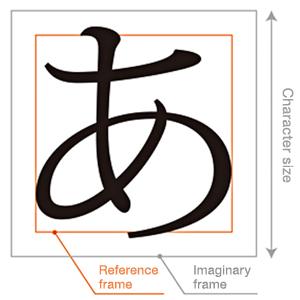
Reference Frames
基準枠
Kijunwaku
A reference frame is a frame constructed within an imaginary body that would coincide with the outer edge of the surface of a piece of type. The font is designed within this reference frame. It is not simply the case that a character can be design
-
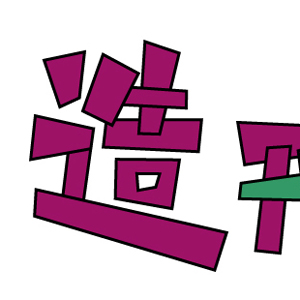
Logotype Design
ロゴタイプデザイン
Logotype Design
The term “logotype” was originally used in printing to refer to the casting of type that contained multiple characters on a single piece of type, such as Æ. Today, the term has come to refer to characters that capture a company’s or organization’s n
-
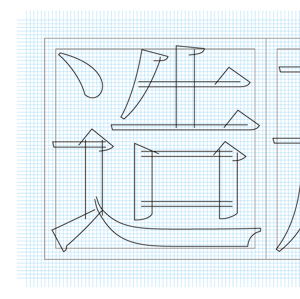
Lettering
レタリング
Lettering
“Lettering” refers to the writing of characters/letters. This can refer to, among other things, traditional styles of writing known as shodō and calligraphy, in which a style is refined with the efficacy of the characters’ shapes in mind; to typeface
-
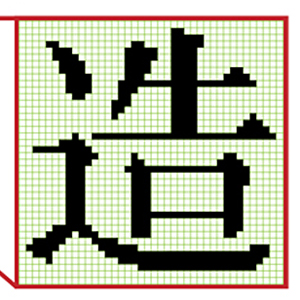
Fonts
フォント
Fonts
“Font” used to refer to a single set of metal movable type of the same style in the same size. A “single set” referred not just to the twenty-six letters of the alphabet, in the case of European languages, but each of those letters in both upper- and
-
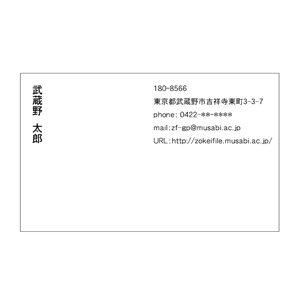
Typography
タイポグラフィ
Typography
Typography originally referred to the technique of letterpress movable type printing, but today refers more broadly to the technique of arranging characters for the production of printed materials. Since the invention of printing technology by Gut
-

Typeface Design
タイプフェイスデザイン
Typeface Design
The word “typeface” originally referred to the face of a piece of metal type; from that it came to designate a uniform style of design shared by a set of type. It is now used for the digital fonts that are used on computers in place of physical movab
-
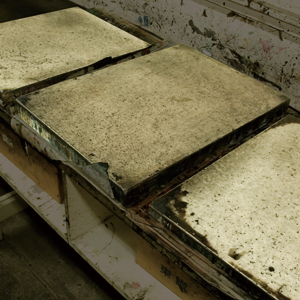
Ink Slab
インク台
Ink-dai
A printmaker uses an ink slab, basically the equivalent of a painting palette for printmaking, to mix and roll ink. Most ink slabs are made out of marble (natural or artificial) or thick chamfered glass (approximately 1 cm thick). Hard, heavy, and
-

PDF
PDF
PDF
PDF (Portable Document Format) is a file format for electronic documents. PDF files use the “.pdf” filename extension.
Originally released in 1993 by Adobe Systems, Inc., the PDF format is now standardized under t
-
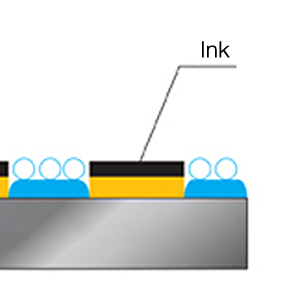
Planography
平版
Heihan
Planography is a format of print work that uses plates with flat, even surfaces. One example of planography is lithography, in which an artist paints directly on a stone or metal plate with a smooth surface and then take advantage of the mutual repul
-

Perspective Drawing (Linear Perspective)
透視図法(線遠近法)
Tōshizuhou (Sen-enkinhou)
Of the many types of perspective, perspective drawing (linear perspective) is the most scientific and organized expression of space. Imagine, for example, that you are standing in the middle of straight road that extends toward the far horizon (HL) a
-
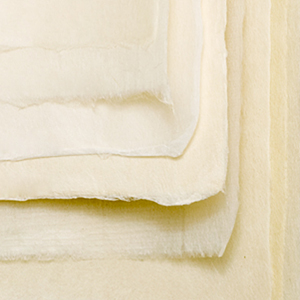
Kōzoshi (Japanese Mulberry Paper)
楮紙
Kōzoshi
Made from paper mulberry, kōzoshi is a strong yet light and supple type of handmade Japanese paper. The paper has many different uses—from applications in painting as a support and lining paper of Japanese-style paintings (nihonga) and paper for wood
-

Honga
本画
Honga
Contrasted with a shitazu (a sketch), a honga is a completed work created with Japanese paints on material such as washi. There are various stages in the creation process of a single Japanese painting : the sketch, first draft, second draft, and f
-

Printing Block
版木
Hangi
A printing block is a wooden board that artists use as a plate material when creating woodblock prints. There are two basic types of printing blocks: a cross-grain type, cut vertically to go with the fiber of the wood, and an end-grain type, cut i
-
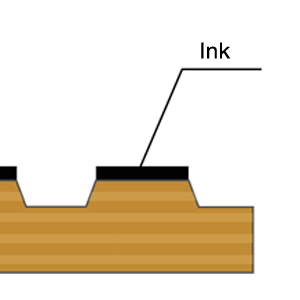
Letterpress
凸版
Toppan
In block printing, letterpress (toppan) is a plate format that uses a plate with a convex surface on its type page. It places ink on the convex section produced on the plate and then produces the print on the paper via pressure from above. The format
-

Copperplate Ink
銅版画用インク
Dōhangayōinku
Copperplate ink is an oil-based ink used in intaglio printing (ōhan), which can be made by mixing the paint with extender pigments such as aluminum hydroxide and burnt linseed or plate oil (as mediums), then knead them together. Copperplate ink co
-
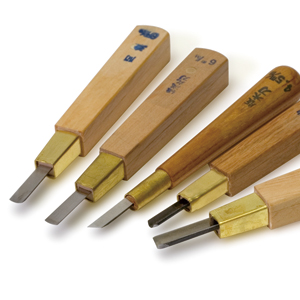
Chisel
彫刻刀
Chōkokutō
The chisel (chōkokutō), a carving knife used in woodcut printing, is a wood-handled, steel-bladed tool for carving into printing blocks. Chisels take their names from their tip shapes. In general, there are four widely used kinds of chisel: the cu
-
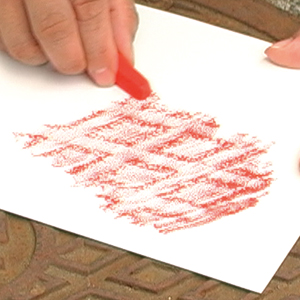
Takuzuri Rubbing
拓刷り(拓摺り)
Takuzuri
Takuzuri rubbing is one of the techniques of letterpress printing (toppan). It is a rubbing-printing method that involves transferring the patterns (monyō) and designs (zugara) on the protruding sections onto paper by applying the paper to the engrav
-
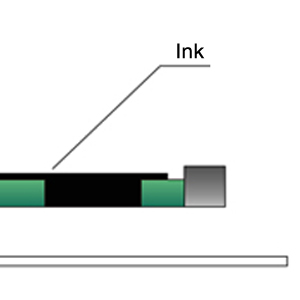
Stencil
孔版
Kōhan
Stencil is a printing format that involves a process of creating a stencil-plate with holes to make an image, covering the template with ink, and applying pressure to push the ink through the holes in the plate, thereby transferring the image to the
-
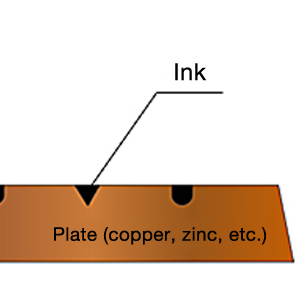
Intaglio
凹版
ōhan
Intaglio is a printing format in which recesses in a printing plate hold the image to be printed. A printmaker fills the recesses made on the plate with ink and applies pressure using a press to make prints. Printmakers use etching or direct engravin
-

Yawara
やわら
Yawara
Damp rags (or uesu) called yawara are used in woodcut printing. Yawara are laid beneath a woodblock to prevent shifting when a printmaker burnishes paper against the woodblock. In woodcut printing, the printmaker applies a considerable amount of f
-

Press
プレス機
Press-ki
A printmaker uses a machine called a press to apply pressure to plates and paper, thereby transferring ink from the plates to the paper. The press is said to have been invented in the 15th century when a grape press was adapted for letterpress pri
-
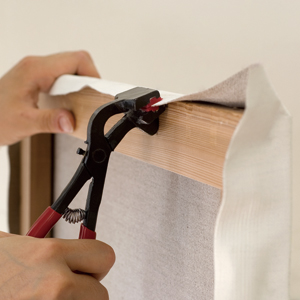
How to Stretch a Canvas
キャンバスの張り方
Canvas no harikata
The construction of a stretched canvas, which is used primarily in oil painting, is (as the name implies) a canvas that has been stretched and affixed to a wooden frame. Artists can easily stretch canvases themselves in various forms and sizes depend
-
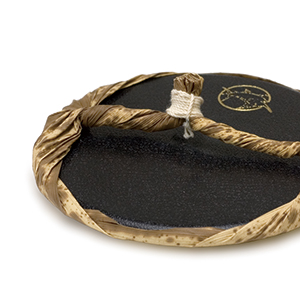
Baren
バレン
Baren
The baren is a burnishing tool that printmakers use to transfer an image on a printing block to paper. The printmaker applies pressure with the baren to burnish paper placed on a printing block so that the paper picks up ink from the block. The ba
-
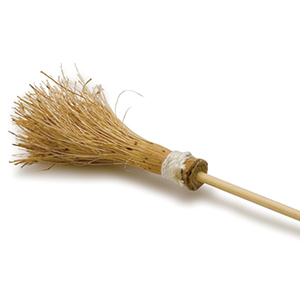
Hakobi
ハコビ
Hakobi
The hakobi, made from finely split bamboo skin that is gathered on a stick like a broom, is used in water-color woodcut printing applications to dissolve paint and transfer the dissolved paint to the woodblock. In use since the days of ukiyoe, printm
-
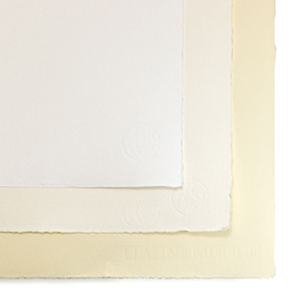
Hahnemuhle
ハーネミューレ
Hahnemuhle
Hahnemuhle, made by the German paper manufacturer Hahnemuhle FineArt, Inc. (founded in 1584), is a form of print paper suitable for copperplate and other intaglio applications. A neutralized paper derived from cotton pulp (100%), Hahnemuhle is adequa
-

Signatures and Editions
サイン・エディション
Signatures and Editions
By signing a completed work, the artist ensures the originality of his or her print works. "Edition" refers to the limited number of copies of the completed work (determined by the artist), and is indicated by the edition number written in the margin
-
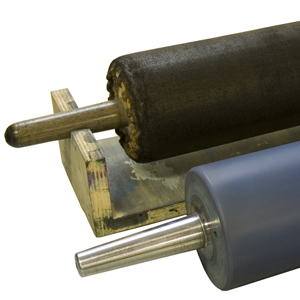
Rollers
ローラー
Rollers
Printmaking rollers are used to apply oil-based ink to printmaking surfaces when using wooden blocks, or when using copperplates or lithographs for chromolithography. There are two types of rollers: leather rollers and synthetic rubber rollers. Le
-
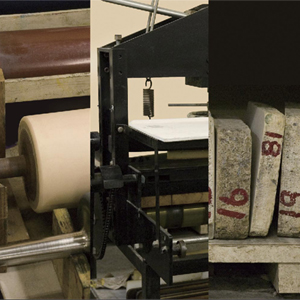
Lithographs
リトグラフ
Lithographs
Lithography is a method of press printmaking that utilizes printing surfaces (planographs) made of such materials as lithographic stone (limestone) or metals (aluminum or zinc plates). The process makes use of water and oil's natural propensity to re
-
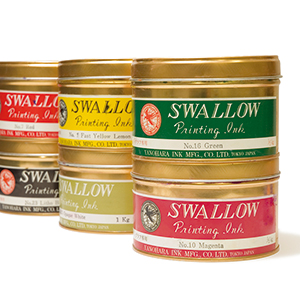
Printing Ink (For Lithographs)
プリントインク(リトグラフ用)
Printing Ink
The printing ink used for lithographs is made by combining linseed oil with pigments. There is another type of printing ink, a fast-drying type made from resin that is used in offset printing, but it is best not to use this ink by itself when prin
-
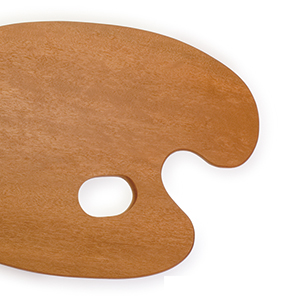
Palettes (For Use with Oil Paints)
パレット(油彩画用)
Palettes
Palettes used in oil painting are surfaces upon which the variously colored oil paints are assembled, and upon which those paints can be blended and their consistency can be adjusted. Depending on the properties of the materials being used for the
-

Tanpo
たんぽ
Tanpo
A tanpo (Chinese: da bao) is a ball of cloth around which another cloth has been wrapped and then tied off at the top with a string, resembling a small pouch. Primarily tanpo are used to apply ink in the process of taking rubbings (takuhon) of cal
-

Ink Spatulas
インクベラ(スパチュール)
Inkubera
Ink spatulas (French: spatule) are a type of spatula used in the printing of woodblocks and other print art when blending colors and adjusting the thickness of the ink, spreading ink on the inking surface, and in cleaning. Spatulas come in a varie
-
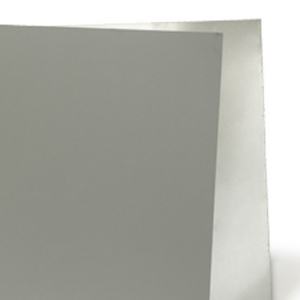
Aluminum Litho Plates
アルミ板
Alumi Ban
Aluminum Litho plates are metallic (aluminum) plates that are used for lithograph prints; when one roughens one face in order to turn it into a surface for printing. Although stones were originally used for lithographic prints, a number of problem
-

T-shaped Kento
T字見当
T-shaped Kento
T-shaped kento is one form of registration mark that is made when producing block prints so that the position of the paper vis-à-vis the blocks is always uniform. They are used primarily with lithographs. Such targets are essential when producing
-

JPEG
JPEG
JPEG
JPEG is one compression method for bitmap image data files. (Originally it was an acronym of the Joint Photographic Experts Group, which developed the compression format.) The human eye is more sensitive to changes in brightness than in hue, and t
-
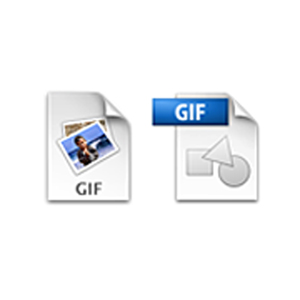
GIF
GIF
GIF
GIF, an abbreviation of Graphics Interchange Format, is one format for bitmap image data files. Its extension is “.gif.” This file format, which utilizes the LZW data compression technique, supports 8-bit (256 color) indexed color. Because it only
-
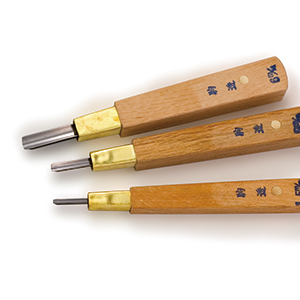
Komasuki
駒透
Komasuki
Komasuki is one type of U gouges, rounded blades in the shape of a half-cylinder that are used to carve into the surface of woodcut printing blocks. “Komasuki” refers specifically to the ones that have a particularly narrow gauge. &
